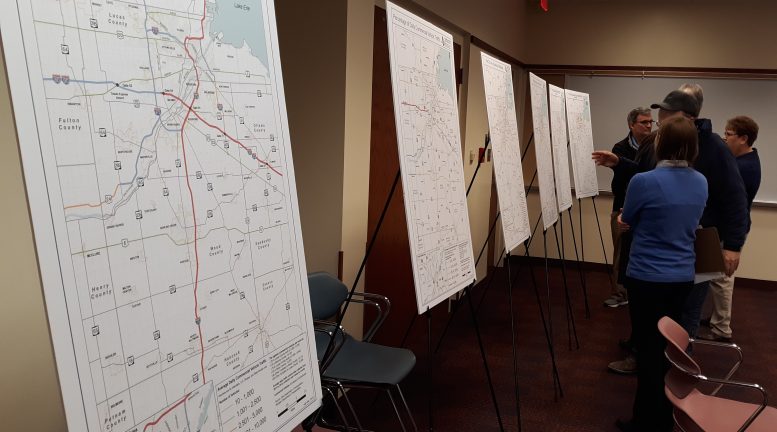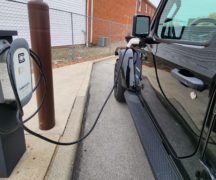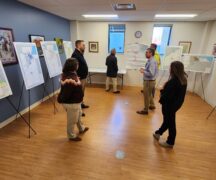By JAN LARSON McLAUGHLIN
BG Independent News
Local motorists had the chance to vent about issues that drive them crazy as they drive through Wood and Lucas counties.
Maybe it’s traffic congestion or getting stuck at railroad crossings. Maybe it’s potholes or not enough public transportation.
Every five years, the Toledo Metropolitan Area Council of Governments updates its long-range transportation plan. But in order to do that, the organization needs to hear from the public. So on Thursday, a meeting was held at the Wood County District Public Library for anyone wanting to talk transportation.
To keep up with transportation needs, the region must have public input, patience in the process, and more funding to design and construct infrastructure. All seem to be in short supply at times.
Maps lined the room, showing some of the transportation issues tracked by TMACOG, such as:
- Top 50 crash intersections in the two counties. Among those were the intersections at Wooster and Main streets, and at Gypsy Lane and South Main streets in Bowling Green, plus Roachton Road and Ohio 199 in Perrysburg Township.
- Top 50 crash sections of roads, which included a section of Ohio 25 between Roachton and Eckel Junction; East Wooster Street from Dunbridge to Mercer roads in Bowling Green; Ohio 51 in Lake Township; Ohio 420 from the turnpike to Genoa Road; and Superior Street between Glenwood and Oregon roads in Rossford.
- The most congested roadways, which include Main Street and Wooster Street in Bowling Green, and U.S. 20 from Lime City to Perrysburg.
- Roadways with high percentages of daily commercial vehicle traffic, including U.S. 6, Ohio 199 and Interstate 75.
- Railways crossing the region.
- Bike trails and lanes.
- Sidewalks.
- Public transit options, including TARTA and Perrysburg Transit.
The long range plan addresses all these modes of transportation.
“In order for it to be a successful plan, we really need input,” said Dana Doubler, transportation planner with TMACOG.
The planners also need patience – since some projects take decades to complete.
“This is a starting point,” Doubler said. “It’s getting your foot in the door.”
“None of these projects happen overnight,” said David Gedeon, vice president of transportation at TMACOG. “They take a long time to develop.”
But lately, the question has been where the money will come from for big transportation projects.
“There is no money for major new projects,” the Ohio Department of Transportation has been telling entities, Gedeon said.
“They didn’t even take applications for projects this year,” he said.
The 18 cent gas tax proposed by Gov. Mike DeWine would help restore those ODOT construction funds, Gedeon said.
“We really need that transportation money to keep up,” he said.
The 10.7 cents per gallon proposed by the Ohio House will not come close to meeting the needs, Gedeon said.
“We just keep on kicking the can down the road,” he said. “In some cases, we know there are projets we need to do, but we just don’t have the money for it.”
Eventually, different long-term solutions will be needed – since people are driving more fuel-efficient vehicles that use less gas, hybrids or electric cars which use no gas.
“We’re not getting the same money from the vehicles on the roadway,” Gedeon said.
TMACOG’s transportation division also looks at air quality, freight traffic issues, safety, environmental sustainability and efficiency.
“It’s not bright and shiny,” but roadways to accommodate freight transportation are very important, Gedeon said.
“That weighs real heavy on industries looking to locate someplace,” he said. “If we don’t have the right infrastructure in place, industry won’t locate here.”
And TMACOG needs to be ready to respond to transportation trends, like self-driving cars, more bike routes, more focus on pedestrians.
“We want to be able to bike safely and efficiently. We want to be able to walk safely and efficiently,” Gedeon said.
“We need to prioritize what’s important for the region, and when,” Doubler said.
“This is to hear what people want,” Gedeon said.
Some of the maps were of particular interest to Sandy Wiechman, who is coordinator of Safe Communities Wood County. She noted the two maps showing high accident rates.
“These two maps, I love,” Wiechman said. “The more information we can get, the better it will be to help out our citizens.”
“I just enjoy looking at them and seeing what we need to know,” she said.
Anyone unable to make Thursday’s public meeting can fill out a transportation survey online at www.tmacog.org/onthemove. The organization wants to hear complaints about potholes or road safety, and requests for bike lanes or public transit.
“Anything related to transportation, we’ll take it,” Doubler said.
“No matter who you are, you should be able to get from where you are to where to want to go,” she said.




